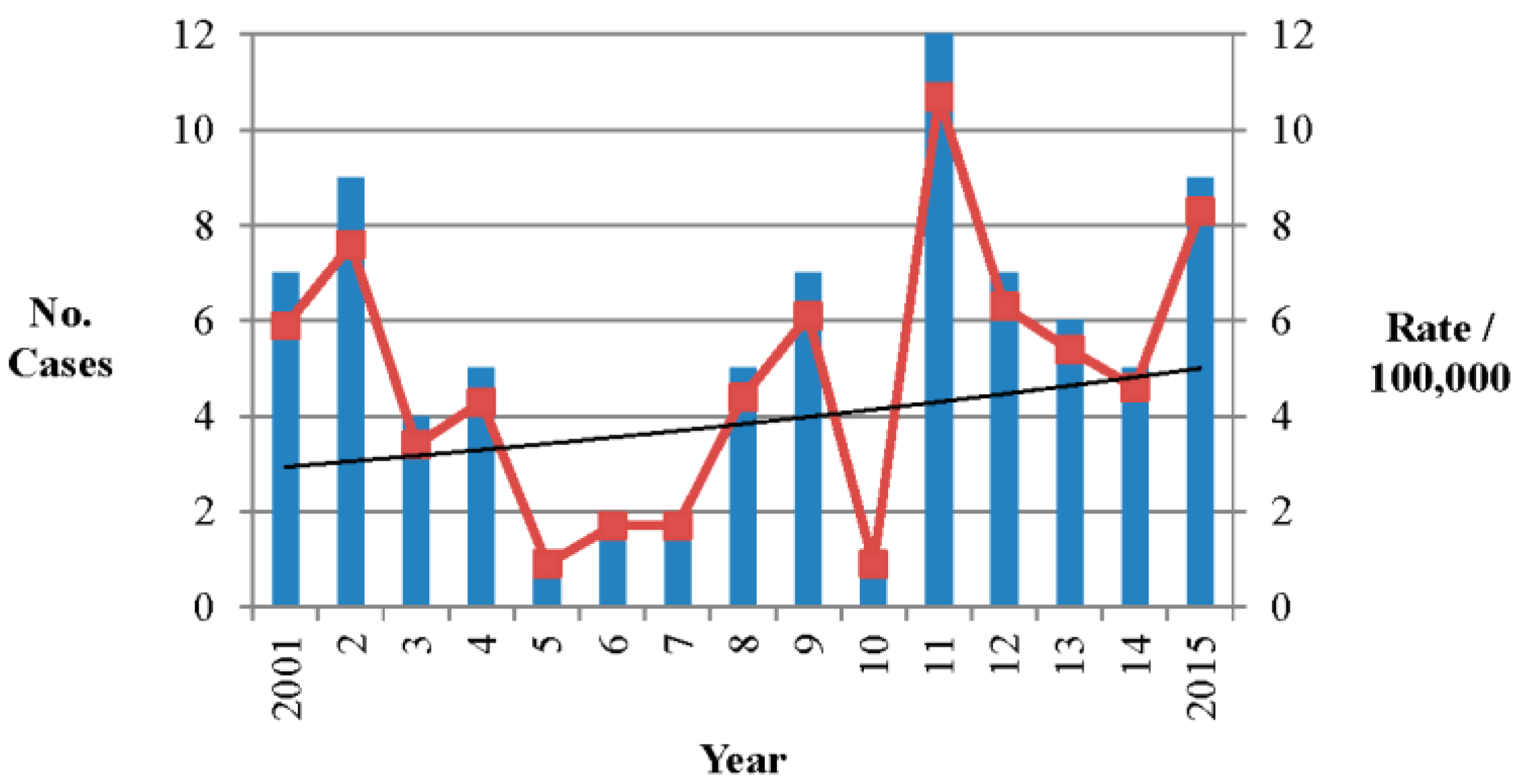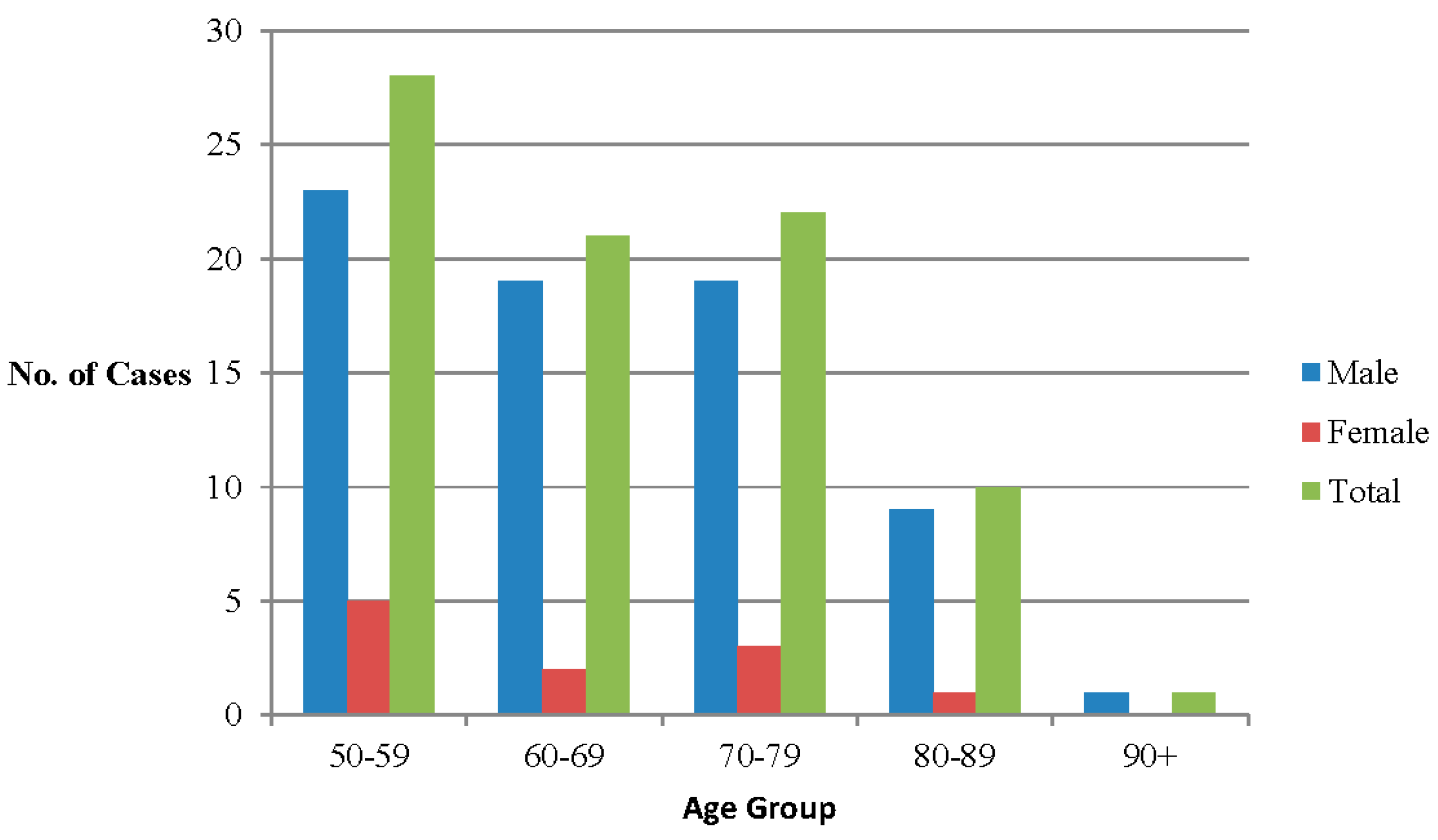Quads, Farmers 50+ Years of Age, and Safety in Australia
Abstract
:1. Introduction
2. Method
3. Results
4. Discussion
5. Conclusions
Author Contributions
Conflicts of Interest
References
- Australian Government Department of Employment. In Industry Information—Agriculture, Forestry and Fishing; Australian Government: Canberra, Australia, 2015. Available online: http://lmip.gov.au/default.aspx?LMIP/IndustryInformation/AgricultureForestryandFishing (accessed on 30 October 2015).
- Australian Bureau of Statistics. Australian Social Trends, December 2012—Australian Farming and Farmers. ABS: Canberra, Australia, 2012. Available online: http://www.abs.gov.au/AUSSTATS/abs@.nsf/Lookup/4102.0Main+Features10Dec+2012 (accessed on 30 October 2015). [Google Scholar]
- Statistics New Zealand. 2013 Census of Population and Dwellings; StatsNZ: Wellington, New Zealand, 2015. [Google Scholar]
- Beaulieu, M. Demographic Changes in Canadian Agriculture. 2015. Available online: http://www.statcan.gc.ca/pub/96-325-x/2014001/article/11905-eng.htm (accessed on 30 October 2015).
- United States Department of Agriculture. Farm Demographics 2015. Available online: http://www.start2farm.gov/usda/knowledge (accessed on 30 October 2015).
- European Commission. EU Agricultural Economic Briefs—Generational Renewal in EU Agriculture: Statistical Background. Available online: http://ec.europa.eu/agriculture/rural-area-economics/briefs/pdf/06_en.pdf: (accessed on 19 February 2016).
- Barr, N. New Entrants to Australian Agricultural Industries—Where Are the Young Farmers? RIRDC: Canberra, Australia, 2014. [Google Scholar]
- Voaklander, D.; Dosman, J.; Hagel, L.; Warsh, J.; Pickett, W.; Saskatchewan Farm Injury Cohort Study Team. Saskatchewan Farm Injury Cohort Study T. Farm work exposure of older male farmers in Saskatchewan. Am. J. Ind. Med. 2010, 53, 706–715. [Google Scholar] [PubMed]
- Voaklander, D.; Day, L.; Dosman, J.; Hagel, L.; Pickett, W. Older farmers and machinery exposure-cause for concern? Am. J. Ind. Med. 2012, 55, 1044–1050. [Google Scholar] [CrossRef] [PubMed]
- Taylor-Gjevre, R.M.; Trask, C.; King, N.; Koehncke, N. Prevalence and Occupational Impact of Arthritis in Saskatchewan Farmers. J. Agromed. 2015, 20, 205–216. [Google Scholar] [CrossRef] [PubMed]
- Nilsson, K.; Pinzke, S.; Lundqvist, P. Occupational injuries to senior farmers in Sweden. J. Agric. Saf. Health 2010, 16, 19–29. [Google Scholar] [CrossRef] [PubMed]
- Marcum, J.; Browning, S.; Reed, D.; Charnigo, R. Farmwork-related injury among farmers 50 years of age and older in Kentucky and South Carolina: A cohort study, 2002–2005. J. Agric. Saf. Health 2011, 17, 259–273. [Google Scholar] [CrossRef] [PubMed]
- Grzebieta, R.; Rechnitzer, G.; Simmons, K.; McIntosh, A. Final Project Summary Report: Quad Bike Performance Project Test Results, Conclusions and Recommendations; UNSW: Sydney, Australia, 2015; Available online: http://www.tars.unsw.edu.au/research/Current/Quad-Bike_Safety/Reports/Final_Summary_Report4-QBPP_Test_Results_Concl_Recom_Jan-2015.pdf (accessed on 8 November 2015).
- Lower, T. Australian Quad Bike Deaths (2001–2010); Australian Centre for Agricultural Health and Safety: Canberra, Australia, 2012. [Google Scholar]
- Lower, T.; Pollock, K.; Herde, E. Australian quad bike fatalities—What is the economic cost? Aust. N. Z. J. Public Health 2013, 37, 173–178. [Google Scholar] [CrossRef] [PubMed]
- Herde, E.; Lower, T. Farm Related Injuries Reported in the Australian Print Media 2012; Australian Centre for Agricultural Health & Safety: Moree, Australia, 2013; Available online: http://www.aghealth.org.au/tinymce_fm/uploaded/Research%20Reports/farm_related_injuries_2012_report_final.pdf (accessed on 6 March 2015).
- Lower, T.; Munro, T.; Peachey, K. Farm Related Injuries Reported in the Australian Print Media 2013; Australian Centre for Agricultural Health & Safety: Moree, Australia, 2014; Available online: http://www.aghealth.org.au/tinymce_fm/uploaded/Research%20Reports/farm_related_injuries_2013.pdf (accessed on 8 November 2015).
- Lower, T.; Munro, T.; Peachey, K. Farm Related Injuries Reported in the Australian Print Media 2014; Australian Centre for Agricultural Health & Safety: Moree, Australia, 2015; Available online: http://www.aghealth.org.au/tinymce_fm/uploaded/Research%20Reports/farm_related_injuries_report_2014.pdf (accessed on 8 November 2015).
- Commonwealth of Australia. Work Health and Safety Regulations 2011 (Revised as at 9 January 2014). Available online: http://www.safeworkaustralia.gov.au/sites/swa/about/publications/pages/model-whs-regulations (accessed on 28 November 2015).
- Denning, G.; Harland, K.; Jennissen, C. Age-Based Risk Factors for Pediatric ATV-Related Fatalities. Pediatrics 2014, 134, 1094–1102. [Google Scholar] [CrossRef] [PubMed]
- Topping, J.; Garland, S. 2013 Annual Report of ATV-Related Deaths and Injuries. US Consumer Product Safety Commission: Bethesda, MD, USA, 2015. Available online: http://www.cpsc.gov//Global/Research-and-Statistics/Injury-Statistics/Sports-and-Recreation/ATVs/2013ATVAnnualRptATV-Related-Deaths--Injuries.pdf (accessed on 4 December 2015). [Google Scholar]
- Yanchar, N. Preventing injuries from all-terrain vehicles. Paediatr. Child Health 2012, 17, 513–514. [Google Scholar] [PubMed]
- Helmkamp, J.; Carter, M. ATV Deaths Among Older Adults in West Virginia: Evidence Suggesting that “60 is the New 40!”. South. Med. J. 2009, 102. [Google Scholar] [CrossRef] [PubMed]
- Testerman, G.M. Increased all-terrain vehicle crash accidents in older riders. South. Med. J. 2009, 102, 461–464. [Google Scholar] [CrossRef] [PubMed]
- Helmkamp, J.; Marsh, S.; Aitken, M. Occupational All-Terrain Vehicle Deaths among Workers 18 Years and Older in the United States, 1992–2007. J. Agric. Saf. Health 2011, 17, 147–155. [Google Scholar] [CrossRef] [PubMed]
- National Coroners Information System. Available online: http://www.ncis.org.au/ (accessed on 4 December 2015).
- Herde, E.; Lower, T. Farm Injury Optimal Dataset Version 2.1; ACAHS: Moree, Australia, 2013. [Google Scholar]
- Australian Bureau of Statistics. Census of Population and Housing 2006; Age 10 Year Age Groups (AGEP) by Industry of Employment (ANZSIC06) (IND06P); ABS: Canberra, Australia, 2006. [Google Scholar]
- Australian Bureau of Statistics. Census of Population and Housing 2011; AGE10P—Age in Ten Year Groups; ABS: Canberra, Australia, 2011. [Google Scholar]
- Grzebieta, R.; Rechnitzer, G.; McIntosh, A.; Mitchell, R.; Patton, D.; Simmons, K. Supplemental Report—Investigation and Analysis of Quad Bike and Side By Side Vehicle (SSV) Fatalities and Injuries. Sydney, 2015; Available online: http://www.tars.unsw.edu.au/research/Current/Quad-Bike_Safety/Reports/Supplemental_Report_Exam&Analysis_Fatals&Injuries_Jan-2015.pdf (accessed on 19 February 2016).
- Heads of Workplace Safety Authorities. Quad Bike Industry Solutions Program Trans-Tasman Working Group: Industry Strategy for the Reduction of Fatalities and serious Incidents Resulting from on-Farm Use of Quad Bikes 2011; HWSA: Sydney, Australia, 2011. [Google Scholar]
- ANSI/SVIA-1-2010. American National Standard for Four-Wheel All-Terrain Vehicles Equipment Configuration and Performance Requirements; Specialty Vehicle Institute of America: Irvine, California, 2010. [Google Scholar]
- Federal Chamber of Automotive Industries, Australian ATV Distributors’ Position Paper—March 2012; FCAI: Melbourne, Australia, 2012.
- Clay, L.; Hay-Smith, J.; Trehane, G.; Milosavljevic, S. “There are risks to be taken and some just push it too far”: How farmers perceive quad-bike incident risk. Aust. N. Z. J. Public Health 2015. [Google Scholar] [CrossRef] [PubMed]
- Garland, S. National Estimates of victim, Driver and Incident Charcteristics for ATV-Related Emergency Department-Treated Injuries in the United States from January 2010–August 2010 with an Analysis of Victim, Driver and Incident Charcteristics for ATV-Related Fatalities from 2005 through 2007. Bethesda, 2014. Available online: https://www.cpsc.gov/Global/Research-and-Statistics/Injury-Statistics/Sports-and-Recreation/ATVs/ATVSpecialStudyReport.pdf (accessed on 8 November 2015). [Google Scholar]
- Helmkamp, J.C.; Aitken, M.E.; Graham, J.; Campbell, C.R. State-specific ATV-related fatality rates: An update in the new millennium. Public Health Rep. 2012, 127, 364–374. [Google Scholar] [PubMed]
- Shulruf, B.; Balemi, A. Risk and preventive factors for fatalities in All-terrain Vehicle Accidents in New Zealand. Accid. Anal. Prev. 2010, 42, 612–618. [Google Scholar] [CrossRef] [PubMed]
- McIntosh, A.; Patton, D.; Rechnitzer, G.; Grzebieta, R. Injury mechanisms in fatal Australian quad bike incidents. Traffic Injury Prev. 2015. [Google Scholar] [CrossRef] [PubMed]


| Body Region | Primary Cause of Death | Rollover | Non-Rollover | Total | |||
|---|---|---|---|---|---|---|---|
| n | % | n | % | n | % | ||
| Head | Intracranial | 4 | 4 | 4.8 | |||
| Fracture of skull & facial bones | 1 | 2 | 3 | 3.6 | |||
| Other & unspecified | 5 | 3 | 8 | 9.7 | |||
| Sub-Total | 10 | 16.6 | 5 | 33.3 | 15 | 18.3 | |
| Neck | Fracture | 1 | 2 | 4 * | 4.8 | ||
| Injury of nerves and spinal cord at neck | 1 | 1 | 1.2 | ||||
| Other and unspecified injuries | 1 | 1 | 2 | 2.4 | |||
| Sub-Total | 2 | 3.3 | 4 | 26.6 | 7 * | 8.5 | |
| Thorax | Fracture of rib(s), sternum and thoracic spine | 1 | 1 | 2 | 2.4 | ||
| Injury of blood vessels of thorax | 1 | 1 | 1.2 | ||||
| Injury of heart | 1 | 1 | 1.2 | ||||
| Injury of other and unspecified intrathoracic organs | 3 | 3 | 3.6 | ||||
| Crushing injury of thorax and traumatic amputation of part of thorax | 6 | 2 | 7 | 8.5 | |||
| Other and unspecified injuries of thorax | 4 | 4 | 4.8 | ||||
| Sub-Total | 16 | 26.6 | 3 | 20.0 | 19 | 23.1 | |
| Abdomen | Injury of intra-abdominal organs | 1 | 1 | 1.2 | |||
| Crushing injury and traumatic amputation of part of abdomen, lower back and pelvis | 1 | 1 | 1.2 | ||||
| Sub-Total | 1 | 1.6 | 1 | 6.0 | 2 | 2.4 | |
| Multiple | Other injuries involving multiple body regions, not elsewhere classified | 1 | 1 | 1.2 | |||
| Unspecified multiple injuries | 3 | 1 | 4 * | 4.8 | |||
| Sub-Total | 4 | 6.6 | 1 | 6.0 | 6 * | 7.3 | |
| Other | Asphyxiation | 17 | 17 | 20.7 | |||
| Effects of other external causes | 2 | 2 | 2.4 | ||||
| Sub-Total | 19 | 31.6 | - | 19 | 23.4 | ||
| Unknown | 8 | 1 | 14 * | 17.0 | |||
| Sub-Total | 8 | 13.3 | 1 | 6.0 | 14 * | 17.0 | |
| Total | 60 | 73.1 | 15 | 18.3 | 82 * | 100 | |
© 2016 by the authors; licensee MDPI, Basel, Switzerland. This article is an open access article distributed under the terms and conditions of the Creative Commons Attribution (CC-BY) license (http://creativecommons.org/licenses/by/4.0/).
Share and Cite
Lower, T.; Monaghan, N.; Rolfe, M. Quads, Farmers 50+ Years of Age, and Safety in Australia. Safety 2016, 2, 12. https://doi.org/10.3390/safety2020012
Lower T, Monaghan N, Rolfe M. Quads, Farmers 50+ Years of Age, and Safety in Australia. Safety. 2016; 2(2):12. https://doi.org/10.3390/safety2020012
Chicago/Turabian StyleLower, Tony, Noeline Monaghan, and Margaret Rolfe. 2016. "Quads, Farmers 50+ Years of Age, and Safety in Australia" Safety 2, no. 2: 12. https://doi.org/10.3390/safety2020012
APA StyleLower, T., Monaghan, N., & Rolfe, M. (2016). Quads, Farmers 50+ Years of Age, and Safety in Australia. Safety, 2(2), 12. https://doi.org/10.3390/safety2020012





